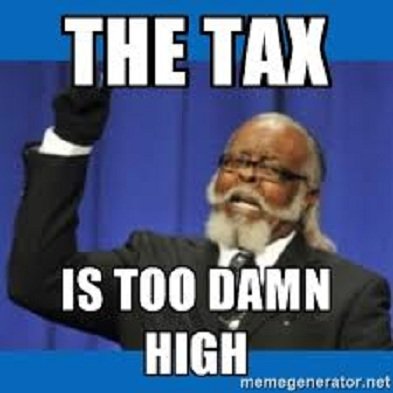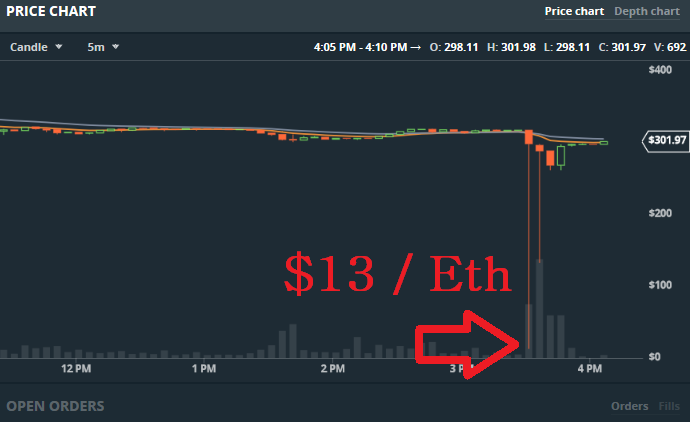In part one, we covered the taxation topic from a more philosophical viewpoint – should Steemit rewards be taxed at all? How do they differ from digital non-assets like Facebook Likes, Reddit Karma, and World of Warcraft Gold? Is Steem Power technically an asset? You can read it by clicking here.

Unfortunately, as the saying goes, only death and taxes are certain. The reality is, barring luck, most of us will have to pay taxes on any significant "earnings" we make. However, the prevailing view that Steem (Power) should be valued "at the time of acquiring as income" represents a gross misunderstanding of how the Order Book works on your average exchange, and of how thin the Steem market really is.

Every market has an Order Book. Here is GDAX's Order Book for Bitcoin, as of today:

You'll notice that on the right is a list of recent trades which are moving the market in either direction. However, the real "meat" is on the left. Notice the green and red slopes? Those represent how many buyers and sellers, respectively, are willing to buy and sell Bitcoin, how much Bitcoin they are willing to sell, and for what price. If you notice the point of my cursor, you will see that "down-to and including" $1502 USD per bitcoin, you could sell a total of 3618.6 Bitcoin for a total of $7,825,687. What does all that mean?
Well, every time a buy or sell is made in an exchange, the price goes up or down a little bit to represent the new equilibrium between supply and demand. More buys means a higher price, and more sells means a lower price.
Currently, on GDAX, if you sold a little under $8 million in Bitcoin, you would crash the price to a minimum of $1502. I say a minimum, because the reality of momentum traders (those who hop on any trend) and already existent stop-loss and sell orders would likely create a cascading effect, and price could be much lower than $1502. However, without extreme buying pressure moving into the market (which is plausible if other exchanges maintain a high price, allowing for arbitrage by buying low at GDAX and selling high at, say, Poloniex), price could not be higher than $1502.
"Lexiconical, what's the point of all this? You only didn't lose me two paragraphs ago because of your 90's commercial!"
Let's consider a hypothetical executive at Apple with a $1 million salary. For this illustration, let's assume that this executive is paid 100% in fully vested Apple shares. In other words, this hypothetical executive's entire salary is paid in fully fungible Apple Stock that he may sell whenever he likes.
At time of writing, Apple trades at $150.27, so our executive's annual salary is 6655 shares of APPL. 20,832,031 shares traded in the previous day's session, totaling approximately $3,130,429,298, or over $3 Billion. The high and low price for this same day is 150.63 / 148.88.
In other words, it took $3,130 Million ($3.1 Billion) in APPL trades to move the price within a 1% high/low band for the day.
You can see why the IRS would want to value this executive's stock at the price "at the time of acquiring", for a number of reasons. It simply makes sense. If you didn't do this, everyone could avoid income tax by being paid in stock. That's not fair to everyone working for dollars, and it ain't gonna put asphalt into the potholes.

Further, there is no injustice (beyond that of the initial taxation without representation or consent) perpetrated by valuing the stock this way. Our executive could cash out his entire year's salary at once, and he would represent only 1/3130 of the day's traded volume, or .00003195%. Considering the full day's trade managed to move the price within only a 1% trading range, assuming this relationship can be roughly extrapolated, our executive could sell his entire year's salary and expect to move the price no more than 1/3130 of 1%, or .0003195%. Perhaps double this number, to account for the fact it is 100% selling pressure, not split evenly on the buy- and sell-sides.
By my calculator, that's a slippage of only 4.8 cents. Slippage is a term for when a buyer or seller gets a different price than they expected when executing their trade, often from their own buying or selling pressure. A slippage of 4.8 cents in our hypothetical example here is well under 1% of 1%. Effectively immaterial. "Pay up", says the IRS, and you can at least identify their logic.

Now, let's consider a Steem Whale doing the same thing: powering down "$1 million" in Steem Power to pay himself a "$1 Million salary". Yesterday's traded volume of Steem across all exchanges (at time of writing) was $1,777,010. Price moved within a huge range from as low as $1.31 to as high as $1.81, which represents an approximately 38% trading range.
In other words, a mere $1.77 Million in trading, or less than double our hypothetical Steem Whale's cash-out, caused a volatility range of almost 40%, low to high. Now, what's really scary (and a fact we ignored above due to it's immaterial nature with those volume numbers) is that only half of this trading volume was buying, because total volume is a measure of all "shares/assets" traded. So, by definition, the selling pressure was about one half of the volume, or $885,000, and we would expect the rest to be on the buying end. Given the price increase, buyers probably outnumbered sellers.
$885,000 of buying led to a day with a 38% volatility range.
In other words, it took only $1.77 Million in Steem trades to move the price within a 38% high/low band for the day. That's 38 times the volatility off of 1/1762 of the trading, relative to APPL shares. That comes out to 66956x the volatility per dollars of Steem sold vs dollar of APPL sold.

That number should destroy any illusions of valuing Steem at the "price of acquiring as income" of even the most ardent IRS apologist. It is so ludicrously removed from reality that even a government that tells almost only lies can't choke back the laughs as that one rolls out. It's a recipe for tax liability that actually exceeds the liquid value of the thing they are attempting to tax. It's an absolute joke.
What do you think will happen if our Steem Whale dumps $1 Million Steem for trade, in a market where $1 buys 66956x the volatility it does in APPL? He will cause a crash in the order book exactly like the the Eth Flash Crash on the GDAX. The price of Steem will slam down so fast that by the time he is done selling, he may be left with $500,000, $100,000, or even less. The ending price of Steem could be 10 cents, 5 cents, or literally 0 if the entire order book has been destroyed.

The absolutely immutable conclusion is that Steem is not worth what it's current price says, except at the thinnest of sales at the very margin. Valuing our hypothetical Steem Whale's quote-unquote "$1 Million in Steem" at $1 Million USD is an outright lie designed to wrongfully enslave our whale by seizing his property. It's impossible to get anywhere near $1 Million for it. I suspect our whale would be lucky to get even half of that.
The absolutely inarguable fact is that anyone valuing their rewards "at the time of receipt" by the rewards estimate is vastly overestimating the true present value of that asset. It's nowhere near that amount. Pathetically small amounts of selling pressure can drive truck-sized holes through the order book, and we haven't even considered fees and other frictional costs (which would be deductible).
In part three, I will cover the complication that powering down adds, requiring an average of 13-weeks of price data from the future to value SP currently, providing another reason why "valuation at the time of acquiring" is nonsensical.
In part four, I hope to give my own take on a fair way to file one's Steemit taxes. Those that I haven't yet bored to tears will hear all about the excitement of "qualified dividends being taxed at the capital gains rate".
In a bonus part five, I hope to take questions and cover a few potential outside-the-box ideas for reducing tax liability that may not make it into part four. Island vacations and trust divulgments, oh my!
IMPORTANT NOTE: I do not advise making tax decisions based on this post. The IRS is an unconstitutional organization that most closely resembles the authority of a fascist state. You don't want to be a trend-setter in this area. I expect that anyone attempting to justify large amounts of Steem Power earnings using these arguments will be bullied and potentially jailed. You must maintain a consistent tax reporting strategy that is internally logical and consistent if you wish to rely on the "good faith" clause to avoid penalties in the future:
"IRC 6664(c) provides a reasonable cause exception to the penalties under IRC 6662 and IRC 6663 where the taxpayer had reasonable cause and the taxpayer acted in good faith. The reasonable cause exception in IRC 6664(c) applies to all of the components of the accuracy-related penalty on underpayments and the fraud penalty, except for any portion of an underpayment that is attributable to one or more transactions lacking economic substance as described in IRC 6662(b)(6), or that is attributable to a gross valuation overstatement with respect to charitable deduction property. In addition, there are special reasonable cause rules outlined in IRC 6664(c)(3) for certain substantial valuation overstatements."
Tag @exyle, you're it!
IMPORTANT NOTE AGAIN: I AM NOT A PRACTICING ACCOUNTANT. YOUR TAXING AUTHORITY IS PRACTICALLY ABOVE THE LAW. PROCEED AT YOUR OWN RISK WITH ALL TAX LIABILITY REDUCTION STRATEGIES. DO NOT BE THE GUY IN JAIL BECAUSE SOME DUDE WITH A LINK TO A COMMERCIAL FOR A 1990'S BOARD GAME BASED ON SHOOTING BALLS AT OTHER KIDS' BALLS RANTED ABOUT TAXES TO YOU ON SOCIAL MEDIA. GEORGE TAKEI IS NOT A LEGITIMATE SOURCE FOR TAXABLE INCOME CALCULATIONS.
Copywright: The Thin Red Line, Milton Bradley, 3rd Rock From The Sun
Sources: GDAX, The Lexiconoloniex(tm) Exchange, Coindesk.com Eth Chart


